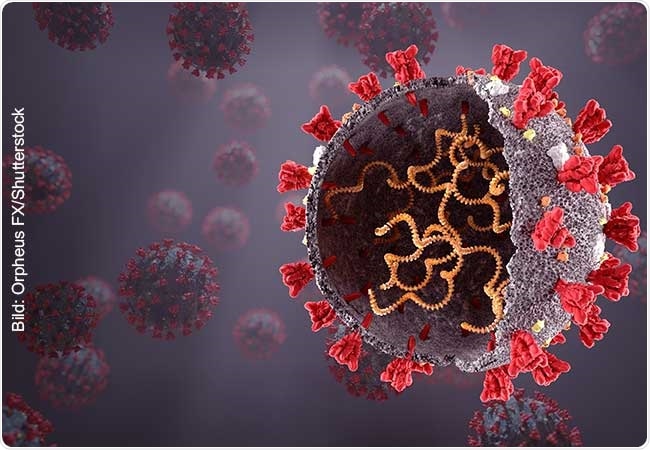Scientists at Goethe University and their collaborators in the international COVID-19-NMR consortium have now identified some regions of the SARS-CoV-2 genome that might be an ideal target for future drugs.

Potential inhibitors of SARS-CoV-2 could not only target viral proteins like the spike protein (red), but also act directly on the viral RNA (yellow, inside the virus). Image Credit: Orpheus FX/Shutterstock.
They used dedicated substance libraries to identify several small molecules that attach to specific areas of the SARS-CoV-2 genome that are virtually never modified by mutations.
Upon infecting a cell, the SARS-CoV-2 virus introduces its RNA into it and reprograms it such that the cell initially synthesizes viral proteins and then whole viral particles.
The researchers were looking for active substances against SARS-CoV-2 and so far mainly focused on the viral proteins and on ways to block them because this has the potential to prevent, or at least slowdown, replication. However, by attacking the viral genome, which is a long RNA molecule, viral replication can even be stopped or slowed down.
Now, researchers in the COVID-19-NMR consortium, coordinated by Professor Harald Schwalbe from the Institute of Organic Chemistry and Chemical Biology at Goethe University, have completed a crucial first step in developing such a new class of SARS-CoV-2 drugs.
They discovered 15 short segments of the SARS-CoV-2 genome that are mostly similar in different coronaviruses and are identified to carry out essential regulatory functions. These segments were not much affected by mutations even in the course of 2020.
The team allowed a substance library of 768 small, chemically simple molecules to interact with the 15 RNA segments and studied the result through NMR spectroscopy. NMR spectroscopy involves first labeling molecules with special types of atoms (stable isotopes) and then exposing them to a powerful magnetic field.
A short radiofrequency pulse is used to excite the atomic nuclei, which consequently emit a frequency spectrum. This spectrum can be used to identify the RNA and protein structure and how and where small molecules attach.
Thus, the researchers headed by Professor Schwalbe were able to identify 69 small molecules that attach to 13 of the 15 RNA segments.
Three of the molecules even bind specifically to just one RNA segment. Through this, we were able to show that the SARS-CoV-2 RNA is highly suitable as a potential target structure for drugs. In view of the large number of SARS-CoV-2 mutations, such conservative RNA segments, like the ones we’ve identified, are particularly interesting for developing potential inhibitors.”
Harald Schwalbe, Professor, Institute of Organic Chemistry and Chemical Biology, Goethe University
“And since the viral RNA accounts for up to two-thirds of all RNA in an infected cell, we should be able to disrupt viral replication on a considerable scale by using suitable molecules,” added Professor Schwalbe.
In this context, Schwalbe added, the team has already begun follow-up trials with readily available substances chemically similar to the binding partners from the substance library.
Source:
Journal reference:
Sreeramulu, S., et al. (2021) Exploring the druggability of conserved RNA regulatory elements in the SARS-CoV-2 genome. Angewandte Chemie. doi.org/10.1002/anie.202103693.